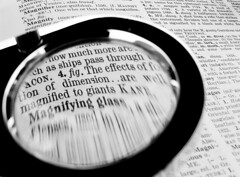
- Image by chrisjohnbeckett via Flickr
What do authors say when they are caught publishing duplicated text and figures from another paper? More than you’d imagine!
Using eTBLAST to detect sequence similarity among texts, Tara Long and others from the University of Texas Southwestern Medical Center identified over 9,000 articles in MEDLINE with high levels of similarity but no overlapping authors. Further full-text analysis whittled this list down to just over 200 nearly identical article pairs.
The researchers then contacted the authors of these articles and the editors who published them to get their reactions. By guaranteeing anonymity, the researchers received a nearly 90% response rate.
The article, “Responding to Possible Plagiarism,” was published in this week’s issue of the journal, Science.
Most original authors (93%) had no idea their work had been plagiarized and were generally appreciative of being told. Responses from those who had done the copying were a little more diverse:
- 28% denied any wrongdoing
- 35% admitted the deed and were apologetic
- 22% blamed it on coauthors
- 17% were unaware they were listed as an author on the paper
Most of the duplicated articles were published in low-profile journals and were rarely cited, which may explain why they escaped detection by the original authors.
An author of a plagiarized article voiced anger over the breach of ethical conduct:
I strongly condemn such duplicate publication. It is unscientific. It defeats the scientific spirit of discovery.
A plagiarizer, however, seems to miss the point that copying is not acceptable behavior:
I would like to offer my apology to the authors of the original paper for not seeking the permission for using some part of their paper. I was not aware of the fact I am required to take such permission.
Several non-native English writers rationalized their verbatim duplication of other texts, arguing that such practice may not unethical if multiple sources are used:
Because [we] are not from a naturally English-speaking country, we may use exact phrases from a previous publication to express our scientific work. … Similarities between 3 [different articles] should not be considered duplication.
As a result of this research, many editors have taken action, launching internal investigations leading to retraction of some 46 of these articles. One editor, however, seemed quick to distance the journal from any accusation of responsibility or accountability:
Believe me, the data in any paper is the responsibility of the authors and not the journal.
While not the kind of response a reader wants to hear, most journals are not in the position of investigating misconduct. Journals often lack the staff and resources to conduct thorough investigations, and have little authority to punish the guilty (with the exception of blacklisting authors from publishing future articles in one’s journal).
Many argue that the burden of responsibility should be on the universities and funding agencies. Universities are responsible for the employment, promotion, and tenure of its researchers. Funding agencies can sanction current recipients and deny future resources to those lacking scientific integrity. If none of these institutions are willing to take action, for whatever reason, known cases of plagiarism can persist in the literature.
Let the reader beware!
A full list of comments can be found in the article’s supporting material.
![Reblog this post [with Zemanta]](http://img.zemanta.com/reblog_e.png?x-id=df754246-09bd-4c62-9552-3c70536e403b)


